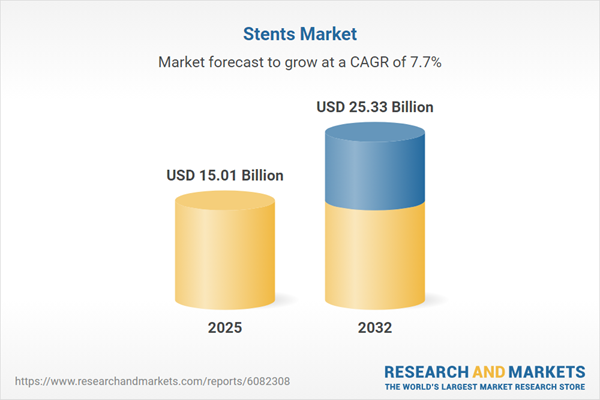Speak directly to the analyst to clarify any post sales queries you may have.
The global stents market is evolving rapidly as healthcare systems worldwide seek innovative solutions to support minimally invasive therapies, address growing disease burdens, and enhance patient outcomes. This report delivers a comprehensive, data-driven analysis for decision-makers navigating an increasingly dynamic medical device landscape.
Market Snapshot: Stents Market Size and Growth Trajectory
The stents market grew from USD 13.95 billion in 2024 to USD 15.01 billion in 2025. It is expected to continue growing with a compound annual growth rate (CAGR) of 7.73%, projected to reach USD 25.33 billion by 2032. Expansion is fueled by rising adoption across clinical applications, technological advancement, and the integration of next-generation stent solutions suited to complex clinical needs.
Scope & Segmentation
- Product Types: Coronary stents, gastrointestinal stents, neurovascular stents (including extracranial carotid artery and intracranial stents), peripheral stents (including carotid, femoral, iliac, renal), urological stents (prostatic, ureteral)
- Material Types: Metallic stents (cobalt chromium, nitinol, platinum chromium, stainless steel), polymeric stents (biodegradable, non-biodegradable polymers)
- Modes of Delivery: Balloon-expandable stents, self-expanding stents
- Applications: Cardiovascular diseases, gastrointestinal obstructions, neurovascular conditions, oncology-related uses, peripheral artery disease, urological disorders
- End Users: Ambulatory surgical centers, cardiology centers, hospitals, specialty clinics
- Regions Analyzed: Americas, Europe, Middle East, Africa, Asia-Pacific (including detailed country-level insights such as the United States, Canada, Brazil, Germany, China, India, Japan, and others)
- Key Companies: Abbott Laboratories, Medtronic plc, Boston Scientific Corporation, Terumo Corporation, B. Braun Melsungen AG, Biotronik SE & Co. KG, Cook Medical LLC, MicroPort Scientific Corporation, Lepu Medical Technology Co., Ltd., Cordis Corporation
Key Takeaways for Senior Decision-Makers
- Continued innovation in stent technology is addressing clinical challenges, such as reducing restenosis and improving biocompatibility through advanced coatings, material science, and sensor integration.
- Emerging digital features, including AI-driven analytics and real-time monitoring sensors, support remote patient management and predictive maintenance on implanted devices.
- Global supply chain strategies are adapting in response to evolving trade environments by emphasizing nearshoring, inventory optimization, and vendor diversification for manufacturing resilience.
- Environmental, social, and governance (ESG) considerations are increasingly shaping procurement and manufacturing, with growing stakeholder demand for eco-efficient production and demonstrated corporate responsibility.
- Competitive dynamics are driven by strategic partnerships, acquisitions, and collaboration across manufacturers, academic centers, and digital health specialists to accelerate adoption of next-generation stent solutions.
Tariff Impact
Recent United States tariff adjustments on raw materials such as stainless steel, nitinol, cobalt chromium, and select polymers are increasing import costs and creating supply chain pressures for stent manufacturers. Industry responses include nearshoring supply, negotiating long-term agreements, and seeking specialized exemptions. Collaboration among regulatory bodies, manufacturers, and trade groups is key to maintaining consistent access to critical medical devices and balancing price pressures with quality patient care.
Methodology & Data Sources
This report draws on rigorous secondary data collection from publications, regulatory filings, and clinical trials, alongside in-depth interviews with clinicians, procurement specialists, and engineers. Quantitative insights were validated through expert panels, scenario modeling, and continuous surveillance of technological and regulatory changes, ensuring reliable and actionable findings for senior leaders.
Why This Report Matters
- Provides holistic insights into global stent development trends, technologies, and emerging clinical innovations relevant for long-term strategic planning.
- Equips decision-makers with timely intelligence on regional market opportunities, risk factors, and evolving regulatory considerations to inform investment and operational priorities.
Conclusion
Staying attuned to technological breakthroughs, supply chain shifts, and regulatory change will be critical for stakeholders seeking to drive growth and enhance clinical value in the stent sector. Forward-looking organizations that leverage these insights will be best positioned to succeed in this complex market landscape.
Table of Contents
3. Executive Summary
4. Market Overview
7. Cumulative Impact of Artificial Intelligence 2025
Companies Mentioned
The companies profiled in this Stents market report include:- Abbott Laboratories
- Medtronic plc
- Boston Scientific Corporation
- Terumo Corporation
- B. Braun Melsungen AG
- Biotronik SE & Co. KG
- Cook Medical LLC
- MicroPort Scientific Corporation
- Lepu Medical Technology Co., Ltd.
- Cordis Corporation
Table Information
| Report Attribute | Details |
|---|---|
| No. of Pages | 197 |
| Published | November 2025 |
| Forecast Period | 2025 - 2032 |
| Estimated Market Value ( USD | $ 15.01 Billion |
| Forecasted Market Value ( USD | $ 25.33 Billion |
| Compound Annual Growth Rate | 7.7% |
| Regions Covered | Global |
| No. of Companies Mentioned | 11 |









